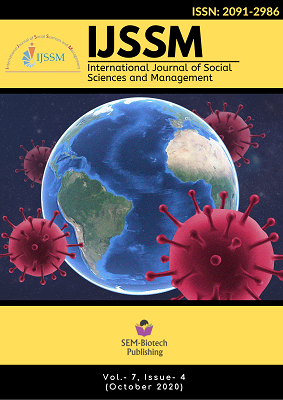Profitability and Resource Use Efficiency of Rice Production in Jhapa District of Nepal
DOI:
https://doi.org/10.3126/ijssm.v7i4.32487Keywords:
allocative efficiency, Cobb-Douglas production function, profitability, rice, return to scaleAbstract
Correction: Due to an oversight two authors were omitted from this paper. On 16th August 2021 Jiban Shrestha and Bidya Kiran Sapkota were added to the list of authors.
This research was conducted from January to June, 2020 to determine the profitability and resource use efficiency of rice production in Jhapa district of Nepal. The primary information was collected from 100 rice growing farmers, randomly selected from the sampling frame, using the pre-tested semi-structured interview schedule; moreover, two Key Informant Surveys were also done. In addition, the secondary information was collected from the review of related literatures. Descriptive statistics, Cobb-Douglas production function were used for data analysis. The gross margin (NRs. 53,531/ha) and benefit cost ratio (2.05) indicated that rice production was profitable with the productivity of 4.5 mt/ha. The return to scale of rice production was calculated 0.86 which indicated that the production function exhibited a decreasing return to scale. The allocative efficiency indices revealed that for optimum allocation of resources, cost on seed, chemical fertilizers and irrigation cum pesticides/herbicides need to be increased by 73.8, 78.4 and 93.9% respectively; while cost on human labor and tractor power should be decreased by 53.8 and 51.5% respectively.
Int. J. Soc. Sc. Manage. Vol. 7, Issue-4: 242-247
Downloads
Downloads
Published
How to Cite
Issue
Section
License
Copyright (c) 2020 International Journal of Social Sciences and Management

This work is licensed under a Creative Commons Attribution-NonCommercial 4.0 International License.
This license enables reusers to distribute, remix, adapt, and build upon the material in any medium or format for noncommercial purposes only, and only so long as attribution is given to the creator.




